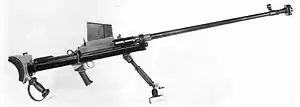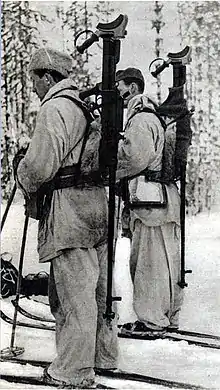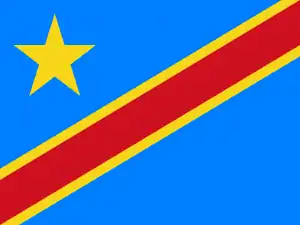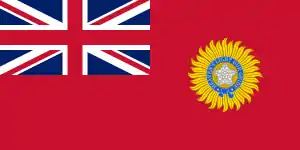Boys anti-tank rifle
The Rifle, Anti-Tank, .55in, Boys, commonly known as the "Boys Anti-tank Rifle" (or incorrectly "Boyes"), was a British anti-tank rifle in use during the Second World War. It was often nicknamed the "elephant gun" by its users due to its size and large bore.[7]
| Boys Anti-tank Rifle | |
|---|---|
 Boys anti-tank rifle Mk I | |
| Type | Anti-tank rifle |
| Place of origin | United Kingdom |
| Service history | |
| In service | 1937–1943 |
| Used by | See Users |
| Wars | Second Sino-Japanese War[1] Winter War World War II Greco-Italian War Continuation War Hukbalahap Rebellion[1] Greek Civil War 1948 Arab-Israeli War[2] Malayan Emergency[3] Korean War[1] The Troubles[4] |
| Production history | |
| Designed | 1937 |
| Manufacturer | Royal Small Arms Factory |
| Produced | 1937–1940 |
| No. built | ~62,000 |
| Variants | Mk I, Mk I*, Mk II |
| Specifications | |
| Mass | 35 lb (16 kg) unloaded |
| Length | 5 ft 2 in (1.575 m) |
| Barrel length | 36 in. (910 mm); Airborne: 30 in. (762 mm) |
| Cartridge | Kynoch & RG .55 Boys |
| Calibre | 0.55 in (14 mm)[5] |
| Action | Bolt |
| Rate of fire | ~10 round/min |
| Muzzle velocity | Mk I: 747 m/s (2,450 ft/s), Mk II: 884 m/s (2,900 ft/s) |
| Effective firing range | 23.2mm penetration at 90° 100 yards (91 m)[6] 18.8mm penetration at 90° 500 yards (460 m)[6] |
| Feed system | 5-round detachable box magazine |



There were three main versions of the Boys: an early model (Mark I) which had a circular muzzle brake and T-shaped monopod, built primarily at BSA in England; a later model (Mk I*) built primarily at the John Inglis and Company in Toronto, Canada, that had a rectangular muzzle brake and a V shaped bipod; and a third model made for airborne forces with a 30-inch (762 mm) barrel and no muzzle brake. There were also different cartridges, with a later version offering better penetration.
Although adequate against light tanks and tankettes in the early part of the war, the Boys was ineffective against heavier armour and was phased out in favour of the hollow charge weapon PIAT mid-war.
Design and development
The eponymous creator of this firearm was Captain Henry C. Boys (the Assistant Superintendent of Design--1885-1937) who was a member of the British Small Arms Committee and a designer at the Royal Small Arms Factory, Enfield. It was initially called Stanchion but was renamed after Captain Boys as a mark of respect when he died a few days before the rifle was approved for service in November 1937.
A bolt action rifle fed from a five-shot magazine, the weapon was large and heavy with a bipod at the front and a separate grip below the padded butt.[8] In order to combat the recoil caused by the large 0.55 inch (13.9 mm) round, a muzzle brake was fitted on the barrel while the receiver was allowed to slide along the frame with a shock absorber attached to the rear of the rifle. The Boys had been designed with numerous small narrow-slotted screws of soft steel set very tight into the body of the weapon and its repair and maintenance proved difficult.[9]
The .55 Boys cartridge was an adaptation of the .50 BMG[10] with a belt added firing a 47.6 gram bullet. At its introduction, the weapon was effective on light armour (23.2 mm thick) at 100 yards (91 m).[6]
There were two main service loads used during the Second World War: The W Mark 1 (60 g AP at 747 m/s) and the W Mark 2 ammunition (47.6 g AP projectile at 884 m/s). The W Mark 1 could penetrate 23.2 mm of armour at 100 yards, about the thickness used on the frontal armour of a half-track or armoured car, or the side or rear armour of a light tank. Later in the conflict, a more effective round was developed, the W Mark 2, which fired a tungsten-cored projectile at 945 m/s. The Boys' effective range against unarmoured targets (for example, infantry), was much greater.
Despite its recoil slide and rubber-cushioned buttpad, the recoil of the weapon (along with noise and muzzle blast) was said to be painful, frequently causing neck strains and bruised shoulders. Consequently, the Boys was almost never fired as a free weapon (that is, not affixed to a support) except in emergencies.[9]
Operational use
The Boys rifle was used in the early stages of the Second World War against lightly armoured German tanks and combat vehicles. Britain also supplied a large number of Boys anti-tank rifles to Finland in 1939 and 1940 during the Winter War with the Soviet Union. The weapon was popular with the Finns because it could deal with Soviet T-26 tanks, which the Finnish Army encountered in many engagements.[1]
Although useful against early German and Italian tanks in France and North Africa, as well as in the Norwegian campaign, such as the Panzer I, Panzer II and early models of Panzer III, increases in vehicle armour during the Second World War left the Boys largely ineffectual as an anti-tank weapon. A shortened version was deployed in 1942 for issue to airborne forces and saw use in Tunisia, where it proved completely ineffective because of the reduced velocity caused by the shortened barrel.[11] Another limitation was that the Boys rifle was relatively heavy and unwieldy to carry and set up.
The Boys' reputation after the Battle of France was such that the Canadian government, through the Directorate of Military Training, The Department of National Defence and National Film Board of Canada (NFB) commissioned a training film, Stop That Tank! (1942), from Walt Disney Studios to counter the rifle's "jinx" reputation.[12][Note 1]
Nonetheless, in the European theatre, it was soon replaced by the PIAT (Projector, Infantry, Anti-Tank) in 1943, which first saw service during the Allied invasion of Sicily. In other roles, the Boys saw some use against bunkers, machine gun nests and light-skinned vehicles but was rapidly replaced in British and Commonwealth service, as quantities of the latter weapon became available, by the U.S. .50 BMG calibre M2 Browning machine gun.
Using armour-piercing (AP), armour-piercing incendiary (API), and armour-piercing incendiary tracer (APIT) ammunition, the .50 Browning was just as capable in armour penetration[Note 2] and more devastating when igniting thin-skinned vehicles using incendiary rounds than the Boys, and could also serve as an effective anti-aircraft weapon. The heavier Browning, however, was not "man-portable" at 38 kg (84 lb) without tripod and 58 kg (128 lb) with tripod. Even the British Special Air Service, which made much use of captured or cast-off weapons for their jeeps and reconnaissance vehicles, quickly got rid of their Boys rifles in favour of M2 Brownings or the Italian 20mm Breda cannon.
The weapon was standard issue to British and Commonwealth forces which attempted to stem the Japanese onslaught through the Pacific theatre. At Milne Bay, the weapon proved completely ineffective. It also failed to stop Japanese tanks in Malaya. Some accounts claim that the 1/14th Punjabi Regiment knocked out two light Japanese tanks at a roadblock.[11] During the Battle of Singapore, the 1st Bn Cambridgeshire Regiment claims the Boys was very useful in knocking holes through walls during street fighting. After the war in the Pacific, the gun was used by Royal Malay Regiment to fight against communist insurgents during Malayan Emergency.[3]
The U.S. Marine Corps purchased Canadian Boys rifles prior to the attack on Pearl Harbor. They saw limited use by the Marine Raider Battalions against enemy bunkers and aided in shooting down two seaplanes off Makin Island.[14] The U.S. Army's 1st Ranger Battalion was also equipped with Boys, but they were not used in combat. The other five Ranger battalions were authorized Boys, but were not equipped with them.
The Boys rifles were also used by the Chinese Nationalist Army during the late Second Sino-Japanese War in both China and Burma.[15]
The Boys rifle was also equipped and used by the Philippine Army and Philippine Constabulary during the Second World War against the Japanese occupation and to aid the Allied liberation. Following the Post-Second World War era, it was operated during the Hukbalahap Rebellion against the Hukbalahap Communist fighters in Central Luzon[1] and by the Philippine Expeditionary Forces to Korea (PEFTOK) against the North Korean and Chinese Communist forces.[1]
In September 1965, members of the IRA hit the British fast-attack patrol boat HMS Brave Borderer with a Boys rifle, crippling one of her turbines while she was paying a visit to Waterford, Republic of Ireland.[4]
Performance
A manual on the Boys published for the Home Guard in 1944 gave the expected performance against armour ranging from 0.91 in (22.3 mm) at 100 yards square on to 0.35 in (8.8 mm) at 500 yards hitting at a 40 degree angle. The manual also noted that maximum penetration against other materials was 14 in (360 mm) of brick walls and 10 in (250 mm) of sandbags[16]
Users
.svg.png.webp) Australia[17]
Australia[17].svg.png.webp) Canada
Canada China[15]
China[15] Democratic Republic of Congo – a few used by Congolese rebels in 1964–65, possibly supplied by China.
Democratic Republic of Congo – a few used by Congolese rebels in 1964–65, possibly supplied by China. Finland – as 14 mm pst kiv/37, during the Winter War and the Continuation War.[1]
Finland – as 14 mm pst kiv/37, during the Winter War and the Continuation War.[1] France - received a large shipment in exchange for 25mm anti-tank guns.[18]
France - received a large shipment in exchange for 25mm anti-tank guns.[18].svg.png.webp) Nazi Germany - rifles captured after the evacuation of the British Expeditionary Forces in Norway and France were designated 13,9 mm Panzerabwehrbüchse 782(englisch), abbreviated PzB 782(e), in German service.[19]
Nazi Germany - rifles captured after the evacuation of the British Expeditionary Forces in Norway and France were designated 13,9 mm Panzerabwehrbüchse 782(englisch), abbreviated PzB 782(e), in German service.[19] Greece - used by the Hellenic Army during Greco-Italian War and the Greek Civil War
Greece - used by the Hellenic Army during Greco-Italian War and the Greek Civil War British India[20]
British India[20] Ireland[4]
Ireland[4] Israel[21]
Israel[21]_crowned.svg.png.webp) Kingdom of Italy - captured in the North African campaign.[22]
Kingdom of Italy - captured in the North African campaign.[22] Luxembourg
Luxembourg Malaya[3]
Malaya[3] New Zealand[23]
New Zealand[23].svg.png.webp) Philippines[1]
Philippines[1] Poland: Polish Armed Forces in the West[24]
Poland: Polish Armed Forces in the West[24] Portugal[1]
Portugal[1] Soviet Union - received 3,200 Boys rifles via Lend-Lease.[25]
Soviet Union - received 3,200 Boys rifles via Lend-Lease.[25] United Kingdom
United Kingdom.svg.png.webp) United States – used by Marine Raiders.[19] Authorized for US Army Rangers in 1943, but not used. During the Korean War, the Marine Corps borrowed some Boys rifles from Canadian troops, strengthened the action and mounted them with scopes. They were used as long-range sniper rifles on an experimental basis, firing double charged .50 BMG ammunition. These rifles had a range of over 2,000 yards.[26]
United States – used by Marine Raiders.[19] Authorized for US Army Rangers in 1943, but not used. During the Korean War, the Marine Corps borrowed some Boys rifles from Canadian troops, strengthened the action and mounted them with scopes. They were used as long-range sniper rifles on an experimental basis, firing double charged .50 BMG ammunition. These rifles had a range of over 2,000 yards.[26].svg.png.webp) Yugoslav Partisans[27]
Yugoslav Partisans[27]
Vehicle mounting
The Boys Rifle was sometimes mounted on vehicles such as the Universal Carrier ("Bren Gun Carrier"), Humber Light Reconnaissance Car and the Morris CS9, Standard Beaverette and Rolls Royce armoured cars.[18]
References
Notes
- In the National Film Board of Canada production, Letter from Camp Borden (1941), a Canadian sergeant is shown trying to explain the "virtues" of the Boys Mk.1 to a group of doubting recruits.
- Quote: "A review of World War II U.S. .50 caliber AP, API, and APIT ammunition specifications reveals that all armour-piercing varieties of the U.S. .50 BMG cartridge were required to completely perforate 7/8" (22.23 mm) of hardened steel plate armour at 100 yards (91 m).[13]
Citations
- Kenneth Robinson, Laurance (24 July 2018). "Rifle, Anti-Tank, .55in, Boys "Boys Anti-Tank Rifle"". Tank Encyclopedia.
- Sam Katz (1988). Israeli Elite Units since 1948. Osprey Publishing. p. 6. ISBN 9780850458374.
- "Malaysia, armed Malay troopers during the Malayan Emergency". University of Wisconsin. 1950.
- White 2006, p. 130.
- Huon 1988, pp. 339–340.
- Boys Anti-Tank Rifle Mk.I, 1942, Small Arms Training, Volume I, Pamphlet No.5
- Henderson 1958, p. 18.
- Smith 2006, p. 541.
- Dunlap 1996, p. 144
- Williams, Anthony G (January 2013), An Introduction to Anti-Tank Rifle Cartridges
- Weeks 1979, p. 91
- "Walt Disney Goes to War". Life. 31 August 1942. p. 61.
- Barnes 2012, p. 432
- Rottman 1995, p. 18.
- Ness, Leland; Shih, Bin (July 2016). Kangzhan: Guide to Chinese Ground Forces 1937–45. Helion & Company. pp. 311–314. ISBN 9781910294420.
- Boys Anti-tank Rifle - Mark 1 1944. Gale and Polden Ltd p7
- "Boys Mark 1 Anti tank Rifle". awm.gov.au. Australian War Memorial.
- Bishop 2002, p. 212
- Bishop 2002, p. 213
- Sumner, Ian (25 Aug 2001). The Indian Army 1914–1947. Elite 75. Osprey Publishing. p. 62. ISBN 9781841761961.
- Sam Katz (1988). Israeli Elite Units since 1948. Osprey Publishing. p. 6. ISBN 9780850458374.
- Battistelli 2013, p. 32
- Stack, Wayne; O’Sullivan, Barry (20 Mar 2013). The New Zealand Expeditionary Force in World War II. Men-at-Arms 486. Osprey Publishing. p. 45. ISBN 9781780961118.
- Zaloga, Steven J. (1982). The Polish Army 1939–45. Men-at-Arms 117. Osprey Publishing. p. 22. ISBN 9780850454178.
- Zaloga & Ness 1998, p. 197.
- Pegler 2010, p. 55.
- Vukšić, Velimir (July 2003). Tito's partisans 1941–45. Warrior 73. Osprey Publishing. p. 25. ISBN 978-1-84176-675-1.
Bibliography
- Barnes, Frank C. (2012) [1st pub. 1975]. Cartridges of the World: A Complete Illustrated Reference for More Than 1,500 Cartridges. Northfield, Illinois: DBI Books. ISBN 978-1-4402-3059-2.CS1 maint: ref=harv (link).
- Battistelli, Pier Paolo (2013). Italian Soldier in North Africa, 1941-43. London: Osprey. ISBN 978-1-7809-6855-1.CS1 maint: ref=harv (link)
- Bishop, Chris (2002). The Encyclopedia of Weapons of World War II, illustrated edition. New York: Sterling Publishing Company, Inc. ISBN 978-1-58663-762-0.CS1 maint: ref=harv (link).
- Rottman, Gordon (1995). US Marine Corps 1941–45. London: Osprey Publishing. ISBN 978-1-8553-2497-8.CS1 maint: ref=harv (link)
- Dunlap, Roy F. (1996) [1948]. Ordnance Went Up Front: Some Observations and Experiences of a Sergeant of Ordnance, Who Served Throughout World War II with the United States Army in Egypt, the Philippines and Japan, Including Way Stations. With Comment and Opinions on the Many Different Small-arms in use by the Forces Engaged. Los Angeles: Samworth Press, for R & R Books. ISBN 978-1-88484-909-1.CS1 maint: ref=harv (link)
- Henderson, Jim (1958). 22 Battalion War History Branch. Washington, D.C.: Department of Internal Affairs.CS1 maint: ref=harv (link)
- Huon, Jean (1988). Military Rifle & Machine Gun Cartridges. Riverside, Maryland: Ironside International, Inc. ISBN 978-0-935554-05-2.CS1 maint: ref=harv (link)
- Pegler, Martin (2010). Sniper Rifles: From the 19th to the 21st Century. Illustrated edition. London: Osprey Publishing. ISBN 978-1-84908-398-0.CS1 maint: ref=harv (link)
- Smith, Colin (2006). Singapore Burning. London: Penguin. ISBN 978-0-14-101036-6.CS1 maint: ref=harv (link)
- Weeks, John (1979). Small Arms of World War II. New York: Galahad Press. ISBN 978-0-88365-403-3.CS1 maint: ref=harv (link)
- White, Robert Williams (2006). Ruairí Ó Brádaigh: The Life and Politics of an Irish Revolutionary. Bloomington, Indiana: Indiana University Press. ISBN 978-0-253-34708-4.CS1 maint: ref=harv (link)
- Zaloga, Steven J.; Ness, Leland S. (1998). Red Army Handbook 1939–1945. London: Sutton. ISBN 978-0-7509-1740-7.CS1 maint: ref=harv (link)
External links
| Wikimedia Commons has media related to Boys anti-tank rifle. |
- The Enfield designed Anti-Tank Rifle in .55 calibre
- The Boys Anti-Tank Training Rifle in .55/.303 calibre
- The Boys Anti-Tank Rifle with Savage Model 6A .22 rifle as a sub-calibre device
- Boys Airportable Anti-Tank Rifle
- .55", Boys Anti-Tank rifle. Mark 1, Mark 1*, Mark 2 (U.K. and Canada)
- THE 14 mm Model 1937 Anti Tank Rifle (The 0.55 inch "Boys" AT-rifle) Winterwar.com
- AT-Rifles Part 2: Foreign designs Jaegerplatoon.net
- Digger History archived from the original
- Stop That Tank (1942) on YouTube - Film produced by Disney for Canada
- Firing of Boys Mk I Anti-Tank Rifle at the Range on YouTube by Forgotten Weapons